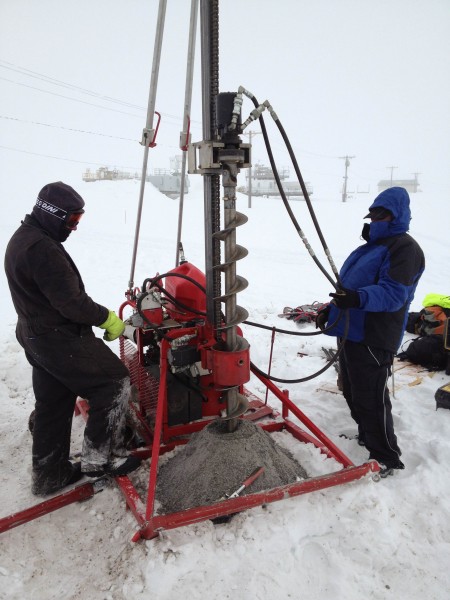Earthquake monitoring arrives in Barrow
July 18, 2014

Lea Gardine
907-474-7664
07/18/14
The first Alaska seismic instrument with EarthScope’s Transportable Array program is in the ground in Barrow, Alaska.
Brian Coyle, deployment coordinator for the program, and his team used a custom drill to auger an 18-foot deep borehole into the frozen arctic soil, where the sensitive instrument was placed. This instrument will remain in the ground for up to five years, detecting not only Alaska earthquakes but also earthquakes of magnitude 5 and greater around the world.
‚ÄúThe Barrow station is a game-changer for earthquake tracking north of the Brooks Range,‚Äù said Michael West, Alaska state seismologist and director of the Alaska Earthquake Center, which is part of –‘”˚…Á‚Äô Geophysical Institute. The earthquake center receives funding from the Incorporated Research Institutions for Seismology to assist in the deployment and data recovery,
“It also improves our ability to monitor the Arctic. Earthquakes, explosions, ice, and meteorological phenomena — in fact, anything that shakes the Chukchi or Beaufort seas — will be easier to detect and better observed with the Barrow site now online."
Coyle’s team will install more than 200 stations in a grid-like array across Alaska in 50-mile intervals. Additionally, select stations currently used for seismic monitoring of the state will be upgraded. These stations are part of the larger, continent-scaled EarthScope project funded by the National Science Foundation, which began in 2004 and aims to look at the geological evolution of North America and the processes controlling earthquakes and volcanic eruptions.
Data recorded at each site will be transmitted to both the earthquake center and IRIS’s Data Management Center in Seattle. Recordings of the live data feed from the Barrow station, named A21K, and all other Transportable Array stations can be viewed online from the IRIS and USArray websites.
The Transportable Array will allow scientists the opportunity to investigate areas of Alaska that have never been studied. At the end of the deployment period, the equipment will either be removed or adapted to become part of Alaska’s monitoring backbone.
ADDITIONAL CONTACTS: Michael West, director of the Alaska Earthquake Center, 907-474-6977, mewest@alaska.edu; Brian Coyle, Transportable Array program deployment coordinator, 907-344-0021, briancgm@gmail.com.
NOTE TO EDITORS: A photo is available for download at .
ON THE WEB:
EarthScope:
USArray: Incorporated Research Institutions for Seismology:
USArray Station Monitor:
LG/7-18-14/015-15


